
Taittinger is a French wine family who are famous producers of Champagne. The estate is currently headed by Vitalie Taittinger, who is the daughter of Pierre-Emmanuel Taittinger, a member of the consultative committee of the Banque de France. Its diversified holdings included Champagne Taittinger, Société du Louvre and Concorde Hotels, whose flagship is the famed Hotel de Crillon on the Place de la Concorde in Paris, France as well as the Loire Valley wine-producing firm of Bouvet-Ladubay, and a partnership in Domaine Carneros in California. All these holdings were sold to Starwood Capital in 2005. The family re-acquired the house of Champagne Taittinger in 2006 after securing financial support from the Crédit Agricole bank and also the backing of trade organisations.
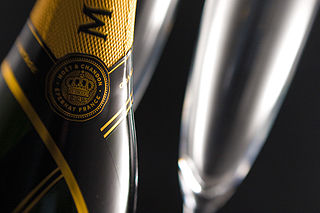
Moët & Chandon, also known simply as Moët, is a French fine winery and part of the luxury goods company LVMH Moët Hennessy Louis Vuitton SE. Moët et Chandon is one of the world's largest champagne producers and a prominent champagne house. Moët et Chandon was established in 1743 by Claude Moët, and today owns 1,190 hectares of vineyards, and annually produces approximately 28,000,000 bottles of champagne.

Mondovino is a 2004 documentary film on the impact of globalization on the world's different wine regions written and directed by American film maker Jonathan Nossiter. It was nominated for the Palme d'Or at the 2004 Cannes Film Festival and a César Award.

Wine labels are important sources of information for consumers since they tell the type and origin of the wine. The label is often the only resource a buyer has for evaluating the wine before purchasing it. Certain information is ordinarily included in the wine label, such as the country of origin, quality, type of wine, alcoholic degree, producer, bottler, or importer. In addition to these national labeling requirements producers may include their web site address and a QR Code with vintage specific information.
The Paris Wine Tasting of 1976, also known as the Judgment of Paris, was a wine competition, to commemorate the United States Bicentennial, organized in Paris on 24 May 1976 by Steven Spurrier, a British wine merchant, and his American colleague, Patricia Gallagher, in which French oenophiles participated in two blind tasting comparisons: one of top-quality Chardonnays and another of red wines. A Napa County wine rated best in each category, which caused surprise as France was generally regarded as being the foremost producer of the world's best wines. By the early 1970s, the quality of some California wines was outstanding but few took notice as the market favored French brands. Spurrier sold predominately French wines and believed the California wines would not be favored by the judges.

Chalone Vineyard is located in the Chalone AVA south of San Francisco, California, United States, on an unusual geological formation called the Gavilan benchland. The soil is rich in limestone and calcium carbonate and also contains a significant amount of decomposed granite. This soil has a mineral composition similar to the Champagne region of France. Chalone is situated in an arid chaparral environment, in which temperatures can vary as much as 50°F in one day. The climate is very dry, only 12 to 14 inches (360 mm) of rain fall per year. These factors combine to create a unique terroir, the signature profile of a wine growing region.

Aubert de Villaine is a social economist and co-owner of the Domaine de la Romanée-Conti; he served as the Domaine's co-director from 1974 to 2021, stepping down to an advisory role in 2022. Some of the world's most expensive wines are produced on several of its approximately 50-acre (20 ha) vineyard holdings in Vosne-Romanée and Montrachet. He was originally co-director with Lalou Bize-Leroy, both having inherited their ownership. However disagreements over the direction of the estate, led to Bize-Leroy's 1991 expulsion from the management and her replacement by her nephews, Charles and later Henry-Frédéric Roch, and eventually Bize-Leroy's daughter, Perrine Fenal, in 2018. De Villaine resigned from co-directorship at the end of 2021 and was replaced by his own nephew, Bertrand de Villaine.

Lebanon is among the oldest sites of wine production in the world. The Israelite prophet Hosea is said to have urged his followers to return to God so that "they will blossom as the vine and fame be like the wine of Lebanon, [and] their fragrance will be like that of Lebanon". The Phoenicians of the coastal strip were instrumental in spreading wine and viticulture throughout the Mediterranean in ancient times.
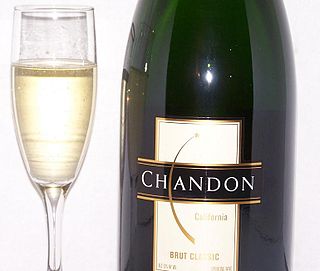
Domaine Chandon is a winery located in the town of Yountville, California, in the Napa Valley. Established in 1973 by Moët et Chandon, and led by businessman John Wright, who operated the company for over 20 years, it was the first French-owned sparkling wine producer in the Napa Valley.

Ceja Vineyards is a family-owned winery in Napa founded by Mexican-American immigrants. The Ceja family have been growers in the Napa and Sonoma valleys in California for three generations. The wine production company was founded in 1999 and focuses on premium wines. The principals are; Amelia Moran Ceja, President; Martha Ceja, Vice President; Pedro Ceja, Secretary; and Armando Ceja, Treasurer. As of 2008 production is around 10,000 cases per year.
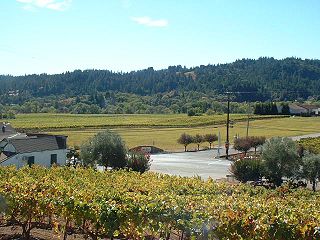
Sonoma County wine refers to the viticulture and winemaking in Sonoma County, California, United States. County names in the United States automatically qualify as legal appellations of origin for wine produced from grapes grown in that county and do not require registration with the United States Department of the Treasury, Alcohol and Tobacco Tax and Trade Bureau.
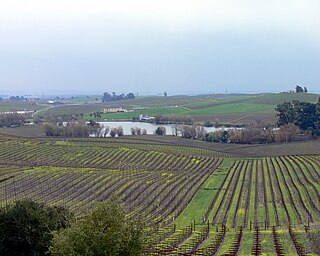
Los Carneros is an American Viticultural Area (AVA) which includes parts of both Sonoma and Napa counties in California, U.S.A. The 37,000 acres (58 sq mi) area was recognized on September 18, 1983 by the Bureau of Alcohol, Tobacco and Firearms (ATF), Treasury after reviewing the petition submitted by Beaulieu Vineyards proposing to establish a viticultural area named "Los Carneros.” The proximity to the cool fog and breezes from San Pablo Bay to the south makes the climate in Los Carneros cooler and more moderate than wine regions farther north in Napa and Sonoma Valleys. The cooler climate has made Los Carneros attractive for the cultivation of cooler climate varietals like Pinot noir and Chardonnay. Many of the grapes grown in Los Carneros are used for sparkling wine production. Receiving its AVA status in 1983, the Carneros area was the first wine region in California to be defined by its climate characteristics rather than political boundaries.

California wine production has a rich viticulture history since 1680 when Spanish Jesuit missionaries planted Vitis vinifera vines native to the Mediterranean region in their established missions to produce wine for religious services. In the 1770s, Spanish missionaries continued the practice under the direction of the Father Junípero Serra who planted California's first vineyard at Mission San Juan Capistrano.

Stéphane Derenoncourt is a French vigneron working as a consultant for numerous estates in Bordeaux and other wine producers worldwide. With his wife, Christine Derenoncourt, he runs Vignerons Consultants and owns Domaine de l'A in the Côtes de Castillon and Derenoncourt California in Napa Valley. He is entirely self-taught.
Château Miraval is a château and vineyard located in the village of Correns, just north of Brignoles, a village in the Var département in the south of France. The château hit headlines in late May 2008 when it was revealed that Brad Pitt and Angelina Jolie had leased it for three years with an option to buy, after surveying prospective properties by helicopter, with the intention of having the twins they expected born in France. Pitt and Jolie exercised the buy option and were married in the château's chapel in August 2014.
Primum Familiae Vini is an association of family-owned wineries with a membership limited to twelve families.
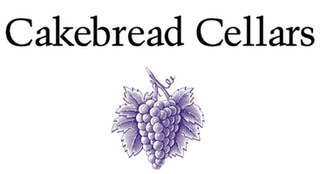
Cakebread Cellars is a Napa Valley winery known for its Chardonnay and Sauvignon Blanc wines, which are internationally distributed. Founded in 1973 by Jack and Dolores Cakebread in Rutherford, California, the winery produces approximately 200,000 cases of wine per year.
Claude Taittinger was a French businessman. He was longtime director of Taittinger Champagne and was the son of Pierre Taittinger.














